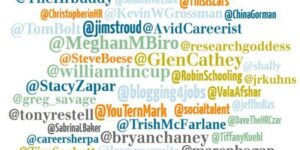
The Power of a Purposeful Hashtag: #WorkTrends
If we’ve learned anything over the past decade, it is the power of a hashtag… #WorkTrends has been on quite an adventure. Over the past

If we’ve learned anything over the past decade, it is the power of a hashtag… #WorkTrends has been on quite an adventure. Over the past

What’s the worst thing an employee can say on any given day? How about, “I don’t belong here?” The schism that takes place when an
I’m super passionate about the importance of Brand Humanization, that mix of culture, community and corporation which can create magic for employees and shareholders, or
I checked my latest Instagram/Facebook picture post and one of the comments read: “You really should have your own reality show, Kevin.” I smiled. KevTV,
Every day we spend our precious time and hard-earned money out in the market searching for new customers. We advertise, we network, we use social
The balance of power is shifting in the employer/employee relationship. What does it mean for the future of work? The #TChat crowd weighs in

The balance of power is shifting in the employer/employee relationship. What does it mean for the future of work? The #TChat crowd weighs in

Small and medium enterprises (SMEs) often start with a good idea and then become successful when they learn to do it well. This often involves

“If one advances confidently in the direction of his dreams and endeavors to live the life he imagined, he will meet with a success unexpected

(Editor’s Note: Our recent guest from the How To Visualize Real-Time Talent Alignment #TChat Show, Matt Norman, had some kind words to share about the

The balance of power is shifting in the employer/employee relationship. What does it mean for the future of work? The #TChat crowd weighs in

The balance of power is shifting in the employer/employee relationship. What does it mean for the future of work? The #TChat crowd weighs in

There’s a basic social contract that exists between workers and their employers. Employees rely on their companies for their living and for a stable work

The balance of power is shifting in the employer/employee relationship. What does it mean for the future of work? The #TChat crowd weighs in

Employee Engagement (defn.): employee’s investment of time, energy, creativity, knowledge, skills and abilities to fulfill expectations of work assigned. Business/Corporate Culture (defn.): the philosophy, values,

The TalentCulture #TChat Show is back live on Wednesday, May 21, 2014. #TChat Radio starts at 6:30 pm ET (3:30 pm PT) and the convo continues on #TChat Twitter chat from

Written by: Michael Ballard Resiliency is defined as, “Our capacity to bounce back.” I define it as, “Our capacity to increase the quality of our

Every company wants increasing employee engagement. Engaged employees are good at communicating and putting forth extra effort to fulfill expectations. I’ve recently seen articles about student

Did you know that when an employee leaves their job, 67% of the time it’s not the job, it’s the boss? Of course you know

According to a recent Gallup study, worldwide, only 13% of employees are engaged at work. In a 142-country study on the State of the Global

Are you selling products to a market? Or are you investing in relationships that will lift your brand? Community counts.

It’s a very merry #TChatHoliday! See Tim McDonald and Kevin Grossman compare end-of-year notes in a brief hangout — and then share your own thoughts!

Looking back at the best of #TChat — with gratitude for everyone who brings the TalentCulture community to life

There are many paths in the world of work. But one thing is for sure — with community along for the ride, it’s never lonely!

What does it take to influence others on social media? An analysis of top recruiting influencers reveals some helpful answers